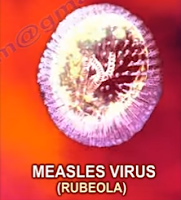Measles, also known as Rubeola, is an extremely contagious
viral infection caused by a Paramyxovirus. It usually occurs in children under
the age of 5 years and the reservoir for this virus is the human respiratory
tract. Transmission occurs through inhalation of infected droplets produced by
infected individuals by sneezing, coughing, or even talking.
Risk factors to contracting this viral infection include:
- Lack of vaccination
- Travelling to endemic areas
- Vitamin A deficiency
- Immunocompromised individuals
The measles virus has an incubation period of 10-14 days
during which the patient has no signs or symptoms. After the 14 days of the
incubation period, the patient will start developing the following signs and
symptoms—fever, cough, coryza (runny nose), and conjunctivitis (pink eye). A characteristic rash also develops which is a
red maculopapular rash appearing first on the face- behind the ears, and then
spreads downwards towards the neck, trunk, arms, legs, and feet. Disease specific
Koplik Spots may develop, which are tiny white spots that appear on the buccal
mucosa.
A measles patient is infective for a total duration of 8
days. Infectivity starts four days before the appearance of the rash and stops
around the fourth day of having the rash. Thus, the patient may appear to be
well and still infect other people.
A diagnosis is usually achieved by thorough history taking
and examination to identify disease specific features such as the unique rash
patter and the characteristic koplik spots. Blood tests could be ordered to
confirm the presence of measles IgM antibodies. Furthermore, respiratory
specimens may be obtained to isolate the virus.
Complications of Measles include:
- Otitis media
- Pneumonia
- Laryngotracheitis
- Subacute sclerosing panencephalitis
Vaccination is quite important and is considered the most
widely used method of prevention. Widespread vaccination leads to herd immunity, which helps to contain the disease and prevent outbreaks. When only a few
individuals are vaccinated, the disease may spread easily through the
population. The measles vaccine is a live attenuated vaccine that is given to
children as part of the MMR (Measles,
Mumps, and Rubella) vaccine. The vaccine is typically administered by the age
of 1 year, followed by a booster dose at the age of 5. The vaccine helps the
individual develop lymphocytes and anti-bodies to attack and eliminate the
virus upon exposure. It is important to remember not to vaccinate
immunocompromised individuals because this is a live attenuated virus vaccine.
Treatment is largely supportive including fluids, fever
reduction, vitamin A, and in some cases, antibiotics may be given to prevent
superinfection.
It is worth noting that a controversy remains regarding the
use of the measles vaccine.



